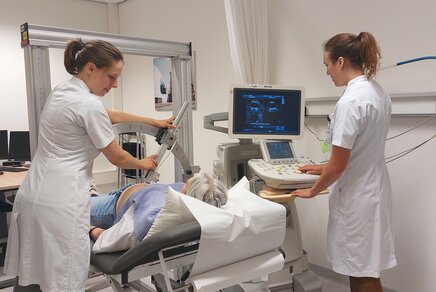How to conquer difficult veins in patients
Nurse anesthetist Rick van Loon has developed a technique that dramatically improves the success rate of inserting intravenous catheters.

In some patients, inserting intravenous catheters is a painful and tricky affair. Nurse anesthetist Rick van Loon of Catharina Hospital in Eindhoven has developed a technique that dramatically improves the success rate. After specific training and with the aid of ultrasound technology, non-specialists can also master this technique. Van Loon will receive his PhD on this subject from the department of Electrical Engineering on Eindhoven University of Technology on Friday, September 24. "It is my dream that in the future no patient will get a failed jab."
It is a common problem in the everyday practice of hospitals: the failure to insert intravenous catheters in patients. In 19 percent of cases, this process - which is known as cannulation - is unsuccessful on the first attempt, because patients have so-called ‘difficult veins’. In his research, Van Loon has shown that by using ultrasound technology that percentage can be brought down to just 7 percent.
"With an ultrasound machine, we can look under the skin of the arm, as it were, and detect veins that are invisible to the naked eye. Veins then become visible on the monitor of the ultrasound machine, which helps us to direct the catheter to the vein."
Anxiety and stress among patients
To determine whether a patient has difficult veins, Van Loon first developed a model to determine each patient's individual risk profile in advance; the Adult Difficult Intravenous Access (A-DIVA) scale.
With the A-DIVA scale, patients are classified according to their individual cannulation success rate. Van Loon: "We distinguish three categories: low-, moderate- and high-risk patients. In the latter group in particular, the success rate during the first attempt is low, only 6 percent."
Research also shows that those patients often experience additional anxiety and stress on top of the anxiety and stress they already have before surgery in the hospital. The researcher has good news for this patient group: "Through my approach, we were able to bring the success rate from 6 to 94 percent. A spectacular improvement!"
The A-DIVA scale is now being used in other hospitals in the Netherlands, and hospitals in Switzerland, the United States and Australia have also shown interest in the new model. It has already been used successfully in a Portuguese hospital.
Special training
"If it turns out that a patient has difficult veins, you can ask someone who is more experienced to perform the procedure. Often a patient will then be taken to the operating room to have an anesthesiologist insert the catheter", Van Loon explains. However, such a procedure is inefficient, logistically complicated and very costly.
That's why he successfully developed a specific course for nurses to train them to use ultrasound when performing cannulation. Studies show that after 34 supervised ultrasound-guided procedures, more than 90 percent of the trainees were able to perform the procedure successfully at their first attempt. "So it's a steep learning curve that can be gone through quickly," says Van Loon.
Van Loon hopes that his research will help make failed cannulations less and less common. "We will never achieve one hundred percent, but any improvement in this area is great news for our patients.”
Rick van Loon will defend his thesis titled Difficult peripheral intravenous cannulation - decision-based application of point-of-care ultrasound to increase cannulation success on Friday September 24th. He was supervised by Erik Korsten, Arthur Bouwman (Catharina Hospital) and Angelique Dierick (Fontys University of Applied Sciences). Van Loon's research was made possible in part by the Catharina Research Fund.
Media contact
More on Health



Latest news


